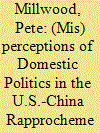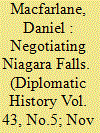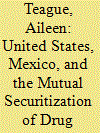|
|
|
Sort Order |
|
|
|
Items / Page
|
|
|
|
|
|
|
| Srl | Item |
| 1 |
ID:
169504


|
|
|
|
|
| Summary/Abstract |
In 1971, the governments of the United States (U.S.) and China resumed a high-level diplomatic dialogue after two decades of nearly hermetic isolation and simmering conflict that had followed the foundation of the People’s Republic of China (PRC) in 1949. More than seven turbulent years later, the two governments “normalized” their relationship and formally resumed official diplomatic relations, having resolved or indefinitely shelved their most fundamental points of conflict. A number of Chinese, U.S., and international scholars have argued that the varying condition of U.S. and particularly Chinese domestic politics was a critical determinant of the sea change in the relationship in this period. The Cultural Revolution dashed tentative U.S. hopes of re-establishing contact in the late 1960s before the winding down of that movement in the early 1970s paved the way for a beginning to rapprochement; the Watergate crisis helped delay normalization beyond President Richard Nixon’s time in office and until the rise of Deng Xiaoping in 1978, whose domestic agenda of rapid modernization expedited a final bilateral agreement.
|
|
|
|
|
|
|
|
|
|
|
|
|
|
|
|
| 2 |
ID:
169501


|
|
|
|
|
| Summary/Abstract |
When the Hawaiian Islands were annexed by the United States in July 1898, it marked the culmination of a chain of events orchestrated by white, mostly American, lawyers and businessmen. In 1887, this group had imposed upon the Hawaiian king, Kalākaua, a constitution effectively stripping the monarchy of its executive powers. Six years later, however, they still found themselves frustrated by the ability of Kalākaua’s successor, Queen Lili‘uokalani, to manipulate the political process. Therefore, in January 1893, they colluded with the U.S. minister to Hawai‘i and troops in Honolulu harbor to elicit the queen’s abdication, and with it the end of the monarchy. The desired annexation to the United States was not immediately forthcoming, so the provisional government declared a republic in July 1894, which endured until U.S. president William McKinley finally intervened to take the islands in 1898.
|
|
|
|
|
|
|
|
|
|
|
|
|
|
|
|
| 3 |
ID:
169503


|
|
|
|
|
| Summary/Abstract |
In the early 1970s, Americans of both parties came to resent what they saw as their government’s acceptance of the United States’ declining global power and the Third World’s rise. In speech after speech at the United Nations, Third World representatives denounced the postwar economic order as unequal and immoral, designed by and for the benefit of rich Western countries (above all the United States). On May 1, 1974—International Labor Day—the UN General Assembly adopted the “Group of 77” (G-77) developing countries’ resolution calling for “economic decolonization” and a “right to development” through the establishment of a New International Economic Order (NIEO).1 Acting just months after Arab members of the Organization of Petroleum Exporting Countries (OPEC) quadrupled the price of oil, the NIEO’s Third World supporters hoped to negotiate a redistribution of money and power from the global North—the rich capitalist countries—to the global South—everyone else but the Communist bloc. Their weapon was control over the price of major commodities, especially oil, that had made possible the United States’ and Europe’s spectacular prosperity after World War II. “What we aim,” explained Venezuela’s President and OPEC leader Carlos Andrés Pérez, “is to take advantage of this opportunity when raw materials, and energy materials primarily, are worth just as much as capital and technology, in order to reach agreements that will ensure fair and lasting balances.”
|
|
|
|
|
|
|
|
|
|
|
|
|
|
|
|
| 4 |
ID:
169505


|
|
|
|
|
| Summary/Abstract |
Niagara Falls is one of the world’s most iconic natural features. Yet in many ways Niagara Falls is decidedly unnatural, for the United States and Canada physically manipulated this waterfall over the course of the twentieth century so that its waters could be diverted for hydropower production while still ostensibly retaining the cataract’s aesthetic beauty for tourism. While this appears contradictory, since the latter depends on ample amounts of water flowing over the Falls while the former requires water going around the Falls, experts believed that they could engineer a compromise and essentially fool the public. Following the 1950 Niagara River Diversion Treaty, the two North American nations constructed hydroelectric stations and remedial works (various engineering interventions including excavations, fills, reclamations, weirs, and dams) at Niagara Falls that allowed for the majority of the water volume to be diverted for power production. Moreover, the largest of the Niagara cataracts, the spectacular Horseshoe Falls, was reshaped in an effort to hide the fact that the majority of the Niagara River’s water volume was abstracted.
|
|
|
|
|
|
|
|
|
|
|
|
|
|
|
|
| 5 |
ID:
169502


|
|
|
|
|
| Summary/Abstract |
Shortly after the atomic bombings of Hiroshima and Nagasaki, the U.S. physicist Louis Ridenour penned a short play for Fortune magazine detailing how a future nuclear war might start. “Pilot Lights of the Apocalypse” opens in an underground command center beneath San Francisco, where a small group of high-ranking military officials give the U.S. president a tour of the facility. The commanding general explains that there are over 5,000 bomb-equipped satellites in orbit above the earth, owned by a host of different countries, ready to strike enemy cities in the event of major hostilities. Because such a strike would descend from outer space, however, determining from where an attack originated is impossible. The command staff must therefore rely on “political” data—an ever-shifting list of political agitators—to determine which enemies might have the greatest motivation to initiate a war.
|
|
|
|
|
|
|
|
|
|
|
|
|
|
|
|
| 6 |
ID:
169500


|
|
|
|
|
| Summary/Abstract |
On February 7, 1985, Mexican drug kingpins abducted Drug Enforcement Administration (DEA) Agent Enrique “Kiki” Camarena, stationed in Guadalajara, Mexico, then the epicenter of Mexico’s drug trade. Mexican and U.S. authorities conducted an intensive manhunt for both Camarena and his kidnappers, and the incident produced bitter conflict between Mexican leaders and the administration of Ronald Reagan. After nearly a month, the mutilated bodies of Camarena and Alfredo Zavala Avelar, a Mexican pilot who flew missions with him, turned up in the state of Michoacán.1 Camarena had cultivated alliances that ultimately led him to his death while embedded in the DEA’s fight against the drug trade in Mexico. According to the DEA’s institutional history, Camarena was “close to unlocking a multi-billion dollar drug pipeline,” a pipeline purportedly linked to the Mexican government.
|
|
|
|
|
|
|
|
|
|
|
|
|
|
|
|
|
|
|
|
|